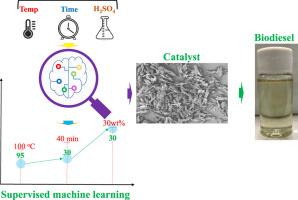Process Safety and Environmental Protection ( IF 6.9 ) Pub Date : 2021-10-20 , DOI: 10.1016/j.psep.2021.10.023 Houli Li 1 , Jin Hu 2 , Yixiao Wang 2 , Xuebin An 3 , Mingzhu Tang 1 , Zhiying Wang 1 , Yunshan Wang 3 , Gang Yang 3 , Weijun Bao 3 , Yong Sun 2, 4

|
In this paper, a biodiesel catalyst was prepared from the phosphogypsum (PG) by a hybrid approach through temperature swing acid leaching/crystallization steps followed by the subsequent fluidized bed calcination. The impacts of acid leaching and crystallization were extensively analyzed via a supervised machine learning approach using a limited number of experimental runs to find out the optimal condition. The determined optimal conditions are X1-95 (ºC), X2-30 (min), X3-30 (wt%-H2SO4), and corresponding validation experimental result (at the optimal condition setting) shows± 5% uncertainties. The prepared catalyst predominately contains CaSO4 (98 wt%) with the impurities less than 0.3 wt% (i.e., P2O5- and F-). The numbers of acid leaching cycles (up to 10 cycles) were investigated, and result indicates a good contaminates recovery (P2O5:1.8 g/100 g PG, Mg2+: 0.3 g/100 g PG, Al3+: 0.3 g/100 g PG, Fe3+: 0.1 g/100 g PG) in the leachate through the downstream solvent extraction. The catalytic conversion reaches about 50% with approximately± 5% deactivation when catalyst was reused at the same transesterification condition. The decreased binding energies of S2p (169.6 eV) and O1st (533 eV) in used catalyst indicate the deactivation of surface catalytic sites. The key properties of the prepared biodiesel are comparable to the American society for testing and materials (ASTM) standards.
中文翻译:

磷石膏废料变温可回收酸工艺的利用及其在酯交换中的应用
在本文中,生物柴油催化剂是由磷石膏 (PG) 通过混合方法通过变温酸浸/结晶步骤和随后的流化床煅烧制备的。酸浸和结晶的影响通过监督机器学习方法使用有限数量的实验运行进行广泛分析,以找出最佳条件。确定的最佳条件为 X 1 -95 (ºC)、X 2 -30 (min)、X 3 -30 (wt%-H 2 SO 4 ),相应的验证实验结果(在最佳条件设置下)显示± 5 % 的不确定性。制备的催化剂主要含有CaSO 4(98wt%),杂质小于0.3wt%(即P 2 O 5 -和F -)。研究了酸浸循环次数(最多 10 次循环),结果表明污染物回收率良好(P 2 O 5 :1.8 g/100 g PG、Mg 2+ : 0.3 g/100 g PG、Al 3+: 0.3 g/100 g PG、Fe 3+: 0.1 g/100 g PG) 在通过下游溶剂萃取的浸出液中。当催化剂在相同的酯交换条件下重复使用时,催化转化率达到约 50%,失活约±5%。使用过的催化剂中 S2p (169.6 eV) 和 O1st (533 eV) 的结合能降低表明表面催化位点失活。制备的生物柴油的关键特性可与美国材料试验协会(ASTM)标准相媲美。










































 京公网安备 11010802027423号
京公网安备 11010802027423号